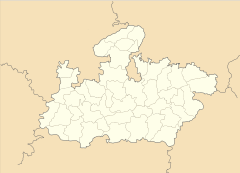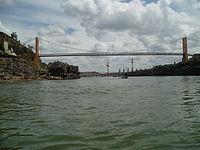- Omkareshwar
-
See Omkareshwar, East Nimar for town of the same name
Omkareshwar Jyothirlinga Location in Madhya PradeshCoordinates: 22°14′59″N 79°9′6″E / 22.24972°N 79.15167°ECoordinates: 22°14′59″N 79°9′6″E / 22.24972°N 79.15167°E Location Country: India State: Madhya Pradesh Location: Madhya Pradesh, India Architecture and culture Primary deity: Omkareshwar(Shiva) Omkareshwar (Hindi: ओंकारेश्वर) is a Hindu temple dedicated to God Shiva. It is one of the 12 revered Jyotirlinga shrines of Shiva.
It is on an island called Mandhata or Shivapuri in the Narmada river; the shape of the island is said to be like the Hindu ॐ symbol.
There are two temples here, one to Omkareshwar (whose name means "Lord of Omkaara or the Lord of the Om Sound") and one to Amareshwar (whose name means "Immortal lord" or "lord of the Immortals or Devas").
But as per the sloka on dwadash jyotirligam, Mamleshwar is the jyotirling, which is on other side of Narmada river.
Contents
Legends & history of Omkareshwar
Omkareshwar Jyotirlinga also has its own history and stories.Three are them are prominent. The first story is about Vindhya Parvat (Mount). Once upon a time Narada (son of Lord Brahma), known for his non-stop cosmic travel, visited Vindhya parvat. In his spicy way Narad told Vindhya Parvat about the greatness of Mount Meru. This made Vindhya jealous of Meru and he decided to be bigger than Meru. Vindhya started worship of Lord Shiva to become greater than Meru. Vindhya Parvat practiced severe penance and worshipped parthivlinga (A linga made from physical material) along with Lord Omkareshwar for nearly six months. As a result Lord Shiva was pleased and blessed him with his desired boon. On a request of all the gods and the sages Lord Shiva made two parts of the lingas. One half is called Omkareshwara and the other Mamaleshwar or Amareshwar. Lord Shiva gave the boon of growing, but took a promise that Vindhya will never be a problem to Shiva's devotees. Vindhya began to grow, but did not keep his promise. It even obstructed the sun and the moon. All deities approached sage Agastya for help. Agastya along with his wife came to Vindhya, and convinced him that he would not grow until the sage and his wife returned. They never returned and Vindhya is there as it was when they left. The sage and his wife stayed in Srisailam which is regarded as Dakshina Kashi and one of the Dwadash Jyotirlinga.
The second story relates to Mandhata and his son's penance. King Mandhata of Ishvaku clan (an ancestor of Lord Ram) worshipped Lord Shiva here till the Lord manifested himself as a Jyotirlinga. Some scholars also narrate the story about Mandhata's sons-Ambarish and Mucchkund, who had practiced severe penance and austerities here and pleased Lord Shiva. Because of this the mountain is named Mandhata.
The third story from Hindu scriptures says that once upon a time there was a great war between Devas and Danavas(demon), in which Danavas won. This was a major setback for Devas and hence Devas prayed to Lord Shiva. Pleased with their prayer, Lord Shiva emerged in the form of Omkareshwar Jyotirlinga and defeated Danavas.
Location
It is situated in the Khandwa district of Madhya Pradesh state in India. It is about 12 miles (20 km) from Mortakka in Madhya Pradesh.
Omkareshwar is formed by the sacred river Narmada. This is one of the most sacred of rivers in India and is now home to one of the world's biggest dam projects.
Transport
There are steamboats across the Narmada river and also two connecting bridges to reach the temple.
Air : The Airports close to Omkareshwar are at Indore (77 km) and Ujjain (133 km).
Rail : Nearest Railway Station is at Omkareshwar Road (12 km) on the Ratlam-Khandwa section of the Western Railway which is not a mainline. The other nearest railway station connected to Delhi and Mumbai is at Indore (77 km).
Road : Omkareshwar is connected to major towns and cities of Madhya Pradesh. There are regular bus services from Indore (77 km), Ujjain (133 km) Khandwa (61 km.) and Omkareshwar Road (12 km). By bus, it takes 2.5 hrs from Khandwa railway station to Omkareshwar.
While traveling from Khandwa to Omkareshwar, on the left side of road in the outskirts of Khandwa you can see the memorial to the celebrated singer, Kishore Kumar.
Gallery
-
View of Narmada
External links
- Jyotirlinga Virtual Darshan
- http://www.templenet.com/Madhya/Omkareshwar.htm
- http://www.narmada.org/
- Omkareshwar temple and Parikrama
Jyotirlinga temples of Shiva Somanātha · Mallikārjuna · Mahākāleśvara · Omkāreśvara · Kedāranātha · Bhimāśankara · Viśveśvara · Tryambakeśvara · Vaidyanātha · Nāgeśvara · Rāmeśvara · GhuṣmeśvaraShaivism Topics
History 
Deities Texts Shvetashvatara Upanishad · Shiva Rahasya Purana · Shiva Purana · Shiv Chalisa · Shiva mahimna stotram · Shiva Sahasranama · Shiva Tandava StotraPhilosophies Jyotirlingas Somnath · Mallikārjuna · Mahakaleshwar · Omkareshwar · Kedarnath · Bhimashankar · Kashi Vishwanath · Trimbakeshwar · Rameshwar · Grishneshwar · Vaidyanath · NageshwarTraditions Category · Portal
Categories:- Hindu temples in Madhya Pradesh
- Khandwa
- Jyotirlingas
Wikimedia Foundation. 2010.







